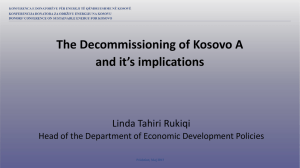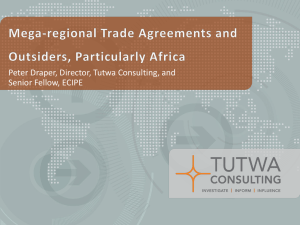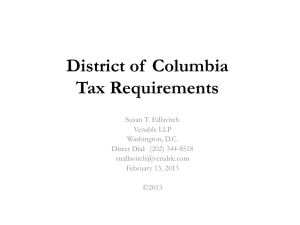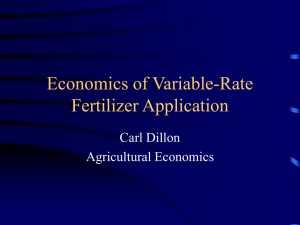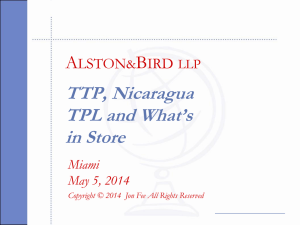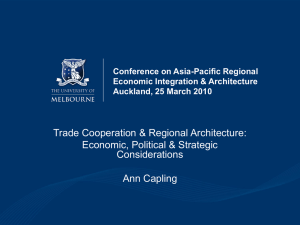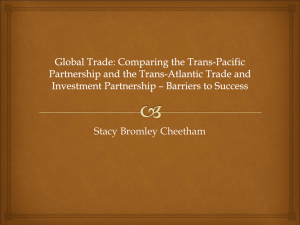CP presentation
advertisement
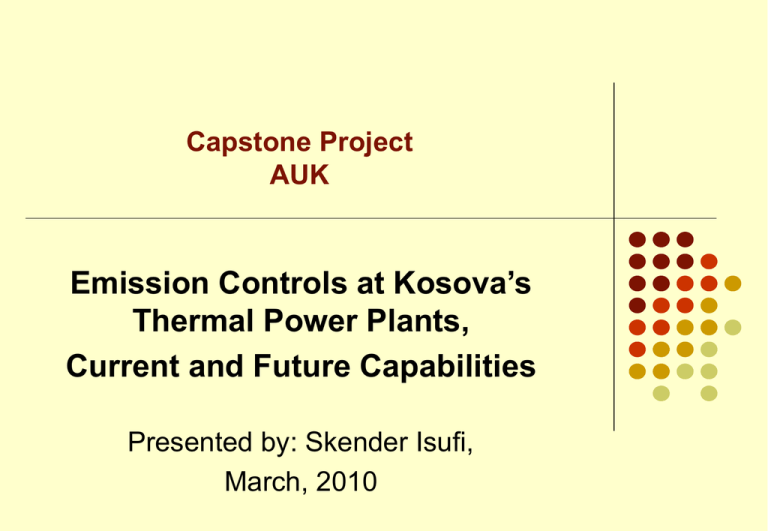
Capstone Project
AUK
Emission Controls at Kosova’s
Thermal Power Plants,
Current and Future Capabilities
Presented by: Skender Isufi,
March, 2010
Problem Background
1.1. Brief description of KEK
Four core Divisions: Coal Production, Generation, Network and Supply
TPP Kosova A (commissioning from 1962 - 1975)
consists of 5 units with installed capacity 800MW
Only 3 units in operation A3, A4 and A5 (available power capacity
450MW)
TPP Kosova B (construction 1983-1984)
consists of 2 units with installed capacity 678MW (available
power capacity 600MW)
HPP Ujman (2 x 17.5MW)
HPP Lumbardhi, (2 x 4MW)
Thermal vs. Hydro electricity generation 97 : 3 %
TPP of Kosova are characterized by:
Old technology of firing and emission control
Aging of units
A3 – 40 years in operation; A4 – 39; A5 - 35
B1 – 27 years in operation; B2 - 26
High specific emissions (especially dust and CO2)
High specific consumption of lignite
For TPP A 1.8 ton of lignite / MWh
For TPP B 1.4 ton of lignite / MWh
Low efficiency of units
in TPP A are 20 – 27%
in TPP B are 30 – 35%
Electricity Generation in Kosova 2001-2008
Demand in 2008 has increased by 60% compared to 2001
Domestic electricity generation in 2008 was 77% higher than
GWh
in 2001
5,000
4,500
4,000
3,500
3,000
2,500
2,000
1,500
1,000
500
0
2001
2002
TPP A
2003
TPP B
2004
2005
HPP
2006
2007
Net import
2008
1.2 Type of Fuel & Lignite Consumption
Cheap energy source (10 billion tons of exploitable reserves, only
Sibovc field 1 billion tons)
Two opencast coal mines: Mirash and Bardh
Type of coal – lignite
LHV = 6500 - 9500kJ/kg
Carbone = 22%
Ash content = 10 - 21%
Moisture = 40 ÷ 45%
Sulphur ~ 0.7 – 1.5% (0.1 – 0.5% organic sulfur)
Extracting ratio 1.7m3 of overburden to 1 ton on lignite
Year
2001
2002
2003
2004
2005
2006
2007
2008
million tons
4.26
5.23
5.64
5.59
6.27
6.35
7.11
7.46
TPP A million tons
2.02
2.24
3.13
1.71
1.27
1.77
2.47
2.44
TPP B million tons
2.23
2.98
2.50
3.88
4.99
4.57
4.64
5.02
Coal
consumption
1.3. Kosova TPP and Environment - Emissions
Air emissions – Dust (particulate mater), SO2, NOx
Greenhouse gas – CO2
The units in TPP A and TPP B are equipped with ESP (electrostatic precipitator electro filter)
Designed dust emission
TPP A - 560mg/Nm3 (3.13kg/MWh)
TPP B - 260mg/Nm3 (1.45kg/MWh)
There are no FGD (flue gas desulphurization) plant (lignite has calcium in it’s
content, which contributes to self-desulphurization)
•
Indicative emissions from units of TPP in Kosova (in mg/Nm3) for 6% O2the average values for 2008 and 2009
Dust emissions
(mg/Nm3)
NOx
(mg/Nm3)
SO2
(mg/Nm3)
For TPP Kosova A
1200 – 1300
700-690
540-750
For TPP Kosova B
300 – 400
800
400-700
EU emission requirements
According to the EU Directive 2001/80/EC the emissions from large combustion
plants for solid fuels
For plants which are put in operation before 2003
(existing and new plants) with >500MWth
For plants which are put in operation after 2003
(new-new plants) with >300MWth
Dust
(mg/Nm3)
NOx
(mg/Nm3)
SO2
(mg/Nm3)
<50/100
<500
<400
<30
<200
<200
o It is required to have a continuous measurement for emissions
o Existing plants (licensed before 1987) may be exempted from the
requirements if they do not operate more than 20,000hrs from 2008
until 2015.
Timing for LCP Directive
Existing
installations
Part A ELV
July
1987
“Old” new
November
2002
“New” new
installations
installations
Part A ELV
Part B ELV
According to the Athens Treaty (2005) – countries adopted this treaty
among others will have to implement the LCP Directive by end of 2017.
(103
bo
u
La rg
tv
ia
M
Li al
th ta
ua
C nia
y
Sw pru
e s
Es den
Sl ton
ov ia
e
Au nia
s
Ko tria
so
H v
un a
Sl ga
o ry
D vak
en ia
m
Ire ark
Be lan
lg d
i
N Fin um
et la
he n
rl d
Po and
rt s
Bu uga
lg l
G aria
re
R ec
om e
C
a
ze
ch Fr nia
R anc
ep e
ub
lic
Ita
P ly
G olan
er d
U
m
ni
an
te
d Sp y
Ki a
ng in
do
m
x tons)
SO2
x tons)
ur
La g
tv
Ko i a
so
Sw va
ed
A u en
D stria
en
m
ar
k
M
a
Li
th lta
ua
n
C ia
N
yp
et
he r us
rla
n
F i ds
nl
S l and
ov
e
Be nia
lg
iu
Ire m
l
S l and
ov
a
Es kia
to
H nia
un
g
C
ze Po ary
ch rtu
Re ga
pu l
bl
ic
Ita
Fr ly
a
G nce
er
m
a
G ny
re
e
U
ni Ro ce
te m
d
a
Ki nia
ng
do
Po m
la
B u nd
lg
ar
i
Sp a
ai
n
(103
xe
m
bo
Lu
xe
m
NOx
Lu
NOx and SO2 emission from LCP in
25 MS of European Union - for 2004
400
350
300
250
200
150
100
50
-
1200
1000
800
600
400
200
0
bo
ur
g
La
t
v
Li
t h ia
ua
ni
a
Cy
pr
u
Sw s
Ne ed
en
th
er
la
nd
s
M
al
ta
Au
st
De ria
nm
a
Sl rk
ov
en
i
Fi a
nl
an
Hu d
ng
a
Po r y
rtu
ga
l
B
Cz
ec elgi
um
h
Re
pu
bl
ic
Ita
Sl ly
ov
ak
i
Ko a
so
va
Ire
la
nd
Fr
an
ce
Un Ge
ite r m
a
d
Ki ny
ng
do
m
Es
to
ni
Bu a
lg
a
Ro r ia
m
an
ia
Sp
ai
n
Po
la
nd
G
re
ec
e
Dust
(103 x tons)
CO2
(million tons)
Li
Lu thu
xe an
m ia
bo
ur
g
La
t
v
Sl i a
ov
ak
ia
M
al
C ta
yp
r
Ko us
so
Sw va
ed
Sl en
ov
en
Au ia
st
Es ria
to
H ni a
un
ga
r
Ire y
l
Po and
rt u
D ga
en l
m
a
Be rk
lg
iu
Fi m
nl
an
Fr d
N
et anc
he e
rla
n
C
ze G ds
ch re
Re ece
pu
bl
ic
Sp
ai
n
Ita
U
ly
ni
t e Pol
d
an
Ki
ng d
G dom
er
m
an
y
Lu
xe
m
Dust and CO2 emission from LCP in
25 MS of European Union - for 2004
60
50
40
30
20
10
0
350
300
250
200
150
100
50
-
Current Emission from units of TPP of Kosova
Years
TPP A
A3
A4
TPP B
B1
B2
Emissions
(in tons)
SO 2
NOx
Particulate
CO 2
SO 2
NOx
Particulate
CO 2
SO 2
NOx
Particulate
CO 2
SO 2
NOx
Particulate
CO 2
2007
986
2,926
3,572
1,099,478
920
2,590
3,321
960,520
1,444
6,514
1,000
2,089,314
1,108
4,843
2,093
1,534,868
2008
2009
2,455
2,767
3,122
2,806
3,751
4,966
1,156,058 1,084,167
1,302
na
1,901
na
2,688
na
700,089
na
3,858
5,691
6,313
7,333
2,202
2,171
2,009,463 2,382,954
4,576
7,782
6,988
7,188
3,485
3,797
2,245,182 2,306,661
Why CO2 emissions
are higher compared
to other emission ?
C content in lignite
22%
Ash content in ignite
10 – 21%
ESP
Project Description
The literature review (books, reports, other information)
Consultations with engineers in KEK
Steps of capstone project
Creating the model for future analysis of emissions
Collecting the necessary information and data
the maximum gross power for existing units of TPP A and TPP B;
the time availability for existing units;
specific lignite consumption;
emissions factors for the different pollutants; and
the formulas for calculations
Evaluate different technologies for new thermal power plant
Conducting the calculations
First step - Defining the scenarios for building the model
Scenario 1 – the existing TPP (Kosova A and B) without abatement
measures
Scenario 2 – the existing TPP with abatement measures (upgrading the
electrostatic precipitators - ESP, only for TPP B), construction of the new
HPP Zhur 293MW and new TPP Kosova C with capacity 1x500MW
Scenario 3 – the existing TPP with abatement measures (upgrading the
electrostatic precipitators - ESP, only for TPP B), construction of the new
HPP Zhur 293MW and new TPP Kosova C with capacity 2x500MW
Scenario 4 – the existing TPP with abatement measures (upgrading the
electrostatic precipitators - ESP, only for TPP B), construction of the new
HPP Zhur 293MW and new TPP Kosova C with capacity 4x500MW
Decommissioning of TPP Kosova A by 2017
The time period for analysis 2010 - 2030
Second Step – Defining the characteristics of existing units
The maximum average gross capacity
for each unit of TPP A - 125MW
for each unit of TPP B - 270MW
The self-consumption of electricity for the units is 9% each
The load factor
for the units of TPP A ( A3- 0.7; A4 - 0.6 and A5 - 0.3).
for units of TPP B - 0.8
Specific lignite consumption
1.75 t lignite/MWh – TPP A
1.4 t lignite /MWh – TPP B
The emission factor:
Dust: 4.76 kg/MWh for TPP A and
1.54 kg/MWh for TPP B.
SO2:
2.73 kg/MWh for TPP A and 2.45 kg/MWh for TPP B
NOx:
2.30 kg/MWh for TPP A and 2.7 kg/MWh for TPP B
CO2:
1.48 t/MWh for TPP A and 1.18 t/MWh for TPP B
Third step - Combustion Technologies for new TPP in
Kosova
Selection criteria: cost, efficiency, and low emissions
Available combustion technologies for future TPP
1.
Pulverized firing with subcritical parameters – PC
Pressure below 221bar
Size up to 1000MW
Requires installation of equipments for emissions control (FGD, low NOx
burners, ESP)
Efficiency is rather low compared to other technologies
High availability, and there is successful experience in design of boilers
Pulverized firing with supercritical or ultra-supercritical parameters – SC
and USC
2.
Similar to subcritical boilers
Operating pressure 230 – 250bar for SC and up to 300bar for USC
Fresh steam temperature up to 600 0C
Requires high quality of material for pipes and blades of turbine (HP&IP part)
Efficiency up to 45% for SC respectively 48% for USC
Third step - Combustion Technologies for new TPP in
Kosova cont’
3.
Circulating fluidized bed combustion – FBC
4.
Similar to PC boilers in many aspects
Operates at lower temperature in furnace (820 – 870oC)
Injection of limestone in furnace to capture SO2
The low temperature limits the formation of NOx
Size of units not larger than 300MW
Integrated gasification combined cycle – IGCC
Gasification of coal and production of synthetic gas
Power is produced from gas and steam turbine
Commercial up to 500MW
Most successful technology for air emission reduction
Summary of Technologies
SC & USC
Status
FBC
SC – commercial up to
Commercial up to
1000MW, ultra SC - needs 250 -300MW
demonstration
IGCC
Commercial up to
500MW
SO2 reduct. (%)
4 - 12
>95
Up to 99
NOX reduct. (%)
4 - 12
30 - 70
80 - 90
CO2 reduct. (%)
4 - 12
Negligible
10 - 20
Efficiency (%)
SC 40 – 42%
Ultra-SC ~ 48%
36 - 38
40 - 44
Capital costs
SC 1000 – 1300 €/kW
ultra-SC: 1400 – 2000 €/kW
600 – 1100 $/kW
up to 3300 $/kW
30 ÷ 70
30 ÷ 45
Fixed O&M costs SC: 25 ÷ 32;
ultra-SC: 30 ÷ 35
($/kW/year)
Step four – Calculations of electricity generations and
emissions estimates for all scenarios
For units in TPP A
and TPP B the
calculation is done
based on the
information given
before
For new units of TPP
“New Kosova” the
calculation are
based on the table
Demand growth 4%
Item
Designation
Unit
Result
[1]
Average gross power
MW
500
[2]
Number of hours per year
hours
8760
[3]
Load factor
-
0.85
[4]
Gross electricity production
GWh
([1] x [2] x [3])/1000=3723
[5]
Net electricity production
GWh
0.9 x [4]=3350.7
[6]
Specific lignite consumption
t/MWh
1.1
[7]
Lignite consumption
kiloton
[6] x [4]=4095
[8]
Specific dust emission*
kg/MWh
0.14
[9]
Dust emission through the stack
tone
[4] x [8]=521
[10]
Specific emission of CO2*
t/MWh
0.85
[11]
CO2 emission
kiloton
[4] x [10]=3481
[12]
Specific emission of SO2*
kg/MWh
0.5
[13]
SO2 emission
tone
[4] x [12]=1852
[14]
Specific emission of NOx*
kg/MWh
1
[15]
NOx emission
tone
[4] x [14]=3723
Project Findings
Electricity production and demand – scenario 1
12000
11000
10000
9000
8000
6000
5000
Import
4000
3000
2000
1000
0
20
10
20
11
20
12
20
13
20
14
20
15
20
16
20
17
20
18
20
19
20
20
20
21
20
22
20
23
20
24
20
25
20
26
20
27
20
28
20
29
20
30
GWh
7000
Net import
Net electricity domestic production
Available electricity
Electricity production and demand – scenario 2
12000
11000
10000
9000
8000
GWh
7000
6000
5000
4000
3000
2000
1000
Import
Import
0
20
09
20
10
20
11
20
12
20
13
20
14
20
15
20
16
20
17
20
18
20
19
20
20
20
21
20
22
20
23
20
25
20
27
20
29
20
30
-1000
Net import
Net electricity domestic production
Available electricity
Electricity production and demand – scenario 3
12000
11000
10000
9000
8000
GWh
7000
6000
5000
4000
3000
2000
1000
Import
0
-1000
Export
-2000
-3000
Net import
Net electricity domestic production
20
30
20
28
20
26
20
24
20
23
20
22
20
21
20
20
20
19
20
18
20
17
20
16
20
14
20
12
20
10
-4000
Available electricity
Electricity production and demand – scenario 4
17000
15000
13000
11000
9000
GWh
7000
5000
3000
Import
1000
-1000
Export
-3000
-5000
-7000
Net import
Net electricity domestic production
20
30
20
29
20
27
20
25
20
23
20
22
20
21
20
20
20
19
20
18
20
17
20
16
20
14
20
12
20
10
-9000
Available electricity
Costs or revenues from net import or net export of
electricity for all scenarios
400.0
Import &
Export price
estimated 45Euro/MWh
350.0
300.0
250.0
200.0
Million Euro
150.0
Revenues
100.0
50.0
0.0
-50.0
-100.0
-150.0
Costs
-200.0
-250.0
-300.0
-350.0
-400.0
2010 2012 2014 2016 2017 2018 2019 2020 2022 2024 2026 2028 2030
Scenario 1
Scenario 2
Scenario 3
Scenario 4
Total CO2 emission forecast for Scenario 1 and 2
10,000
8,000
9,000
7,000
8,000
7,000
5,000
CO2 (kt/a)
4,000
3,000
6,000
5,000
4,000
3,000
2,000
2,000
1,000
1,000
0
0
09 10 11 12 13 14 15 16 17 18 19 20 21 22 23 26 30
20 20 20 20 20 20 20 20 20 20 20 20 20 20 20 20 20
TPP A
TPP B
20
09
20
10
20
11
20
12
20
13
20
14
20
15
20
16
20
17
20
18
20
19
20
20
20
21
20
22
20
23
20
26
20
30
CO2 (kt/a)
6,000
TPP A
TPP B
TPP C
Total CO2 emission forecast for Scenario 3 and 4
12,000
20,000
11,000
18,000
9,000
16,000
8,000
14,000
CO2 (kt/a)
7,000
12,000
6,000
10,000
5,000
4,000
8,000
6,000
3,000
4,000
2,000
1,000
2,000
0
0
20
0
20 9
10
20
11
20
1
20 2
13
20
1
20 4
15
20
16
20
1
20 7
18
20
1
20 9
20
20
2
20 1
22
20
23
20
2
20 6
30
CO2 (kt/a)
10,000
TPP A
TPP B
TPP C
09 010 011 012 013 014 015 016 017 018 019 020 021 022 023 026 030
0
2 2 2 2 2 2 2 2 2 2 2 2 2 2 2 2 2
TPP A
TPP B
TPP C
Emission Trading Scheme and CO2 credits
20
16
14
Cap of CO2=11 million tons
12
10
8
Cap for CO2 emissions form TPP
6
11 million tons
4
2
0
2010 2012 2014 2016 2017 2018 2019 2020 2022 2024 2026 2028 2030
total CO2 emission scenario 1
total CO2 emission scenario 2
total CO2 emission scenario 3
total CO2 emission scenario 4
200
150
Cost of credits for CO2 = 25 €/t
million Euro
million tons of CO2
18
Potential costs for buying
CO2 credits
100
50
0
-50
-100
2018
2019
2020
2022
cost of CO2 scenario 3
2024
2026
2028
cost of CO2 scenario 4
2030
SO2 emission forecast for Scenario 3 and 4
Scenario 4
16,000
12,000
14,000
10,000
12,000
SO2 (t/a)
14,000
8,000
6,000
10,000
8,000
6,000
4,000
TPP A
TPP B
TPP C
30
29
TPP C
20
27
20
25
20
23
20
22
TPP B
20
21
20
20
20
19
20
18
TPP A
20
17
20
16
20
14
20
20
10
20
20
30
20
26
28
20
20
23
24
20
20
21
22
20
20
19
20
20
20
20
20
20
20
20
17
18
0
14
16
0
10
12
2,000
12
4,000
2,000
20
SO2 (t/a)
Scenario 3
NOx emission forecast for Scenario 3 and 4
Scenario 4
Scenario 3
24,000
22,000
22,000
20,000
20,000
18,000
18,000
16,000
16,000
NOx (t/a)
24,000
NOx (t/a)
14,000
14,000
12,000
12,000
10,000
10,000
6,000
6,000
4,000
4,000
2,000
2,000
0
0
TPP B
TPP C
20
20
TPP A
0
20 9
1
20 0
1
20 1
1
20 2
1
20 3
1
20 4
1
20 5
1
20 6
1
20 7
1
20 8
1
20 9
2
20 0
2
20 1
2
20 2
2
20 3
2
20 6
30
8,000
0
20 9
1
20 0
1
20 1
1
20 2
1
20 3
1
20 4
1
20 5
1
20 6
1
20 7
1
20 8
1
20 9
2
20 0
2
20 1
2
20 2
2
20 3
2
20 6
30
8,000
TPP A
TPP B
TPP C
8,000
6,000
TPP A
TPP B
TPP C
0
20 9
1
20 0
1
20 1
1
20 2
1
20 3
1
20 4
1
20 5
1
20 6
1
20 7
1
20 8
1
20 9
2
20 0
2
20 1
2
20 2
2
20 3
2
20 6
30
10,000
Dust emissions [t/a]
12,000
20
0
20 9
1
20 0
1
20 1
1
20 2
1
20 3
1
20 4
1
20 5
1
20 6
1
20 7
1
20 8
1
20 9
2
20 0
2
20 1
2
20 2
2
20 3
2
20 6
30
20
Dust emissions {t/a]
Dust emission forecast for Scenario 3 and 4
Scenario 3
Scenario 4
16,000
16,000
14,000
14,000
12,000
10,000
8,000
6,000
4,000
4,000
2,000
2,000
0
0
TPP A
TPP B
TPP C
Conclusions
Specific emission of CO2 from TPP Kosova A is high due to lower efficiency
compared to units of TPP Kosova B.
Specific emission of CO2 from units of TPP “New Kosova” are 75% lower than
TPP Kosova A or 39% lower than TPP Kosova B.
The scenario 2 is moderate scenario; the total emission will be increased by
20% more than are today. The scenario 3 will have 80% higher total emissions
than current, while for the scenario 4 the emission of CO2 will be three times
more than today.
The simulation with the CO2 trading allowance shows that scenario 4
represents high potential costs for buying credits of CO2.
To comply with CO2 emission reduction only scenario 3 is acceptable
To comply with EU directive 2001/80, scenario 2, 3 and 4 are acceptable
Conclusion - cont’
Because of the aging and high specific emission, TPP Kosova A units has
to be decommissioned by 2017 (not before the new TPP starts operation)
The units of Kosova B power plant, has to refurbish the ESP and to install
low NOX burners to comply with EU Directive 2001/80.
To cover the demand with sufficient and reliable electricity only scenario 3
and 4 are acceptable. These scenarios shows considerable potential for
generation of revenues
The annual demand growth by 4%, requires construction of new power
generation capacities (otherwise we will depend on import)
The assessment of technologies have shown that the best technology is
pulverized firing, subcritical or supercritical pulverized firing. The
equipments for emission control has to be installed.
The existing hydro potential will be utilized and the new HPP Zhur has to
be build by 2018
Recommendation
Implementation of scenario 3 as the best scenario regarding the reduction
of emissions and fulfilling the demand of electricity and crating the condition
to induce the electricity export for considerable period of time.
By 2017 respectively 2018 to make investments in TPP B for improvements
of air emissions by installing low NOx burners and refurbishment of ESP.
The technology for the new power plant is recommended to be subcritical or
supercritical boilers with regard to the characteristics of lignite.
The new units should have installed modern equipments for dust collection –
efficient ESP, low NOx burners, and desulfurization equipments.
Installation of continuous measurement of air emissions NOx, SO2 and dust
on unit B1 and B2 of TPP Kosova B are required by the EU Directive for
LCP.
Utilizing the hydro potential by construction of HPP Zhur to increase the
share of electricity produced by renewable resources (3 to 4 %).
List of References
KEK-Statistical Data, Strategic Development Office
KEK – Working Manual for Boiler and Turbine, Kosovo B Power Plant, 1995
Energy Sector Technical Assistance Project, Module G – Lignite Development Strategy,
World Bank, 2002
Government of Kosova, Ministry of Energy and Mining: (2008): Strategic Environmental
and Social Assessment
Directive 2001/80EC of the European Parliament and the Council, Official Journal of the
European Community, 2001
Entec, (2008), Evaluation of the Member States’ emission inventories 2004-2006 for
LCPs under the LCP Directive (2001/80/EC), Final Report, European Commission
http://eper.ec.europa.eu/eper/emissions_pollutants.asp?i
Power Station Emission Handbook- www.ccsd.biz/PSE_Handbook/index.cfm
Gjurgjeala. B,(2007) Efficiency of TPP, Prishtina
Travoulareas. S & Jozewicz. W, (2005): Multipollutant Emission Control Technology
Options for Coal fired Power Plants, EPA, Washington DC.
www.babcock.com/products/boilers/images/swup.gif
http://www.babcock.com/products/boilers/circulating_fluidized_bed_specs.html
www.ccsd.biz/factsheets/images/igcc1.gif
http://www.power-technology.com/projects/rwe-neurath/
List of References
T. Hatakka, “Vattenfall Capital Markets Day 2009”, Amsterdam 2009,
Presentation (Reviewed online on February 2010 at
http://www.vattenfall.com/en/file/tuomo-hatakka-business-group-_8459841.pdf)
Duke Energy, “Cliffside Steam Station Modernization - Project Overview”:
(Reviewed online January 2010) at http://www.duke-energy.com/aboutus/cliffside-overview.asp)
http://www.miga.org/documents/Maritzabrief.pdf
http://www.energy.ca.gov/2007_energypolicy/documents/2007-0529_workshop/presentations/Dalton_EPRI_Clean_Coal.pdf
http://www.power-technology.com/projects/comanche/
http://www.energyjustice.net/coal/igcc/factsheet.pdf
Course lectures “Energy Policy” – AUK, 2008
The Emission Trading System, http://www.youtube.com/watch?v=y7veRksc_Yk
ElectroWatt – Ekono, Jaakko Pöyry Group, (2006), Pre-feasibility studies for the
new lignite fired power plant and for pollution mitigation measures at Kosovo B
power plant, Lot 2. Prishtina, European Agency for Reconstruction
Carl Bro, (2003), Environmental Impact Assessment and Action plan for Kosova
A and B Power Plants and Coal Mines, European Agency for Reconstruction
Energy Community Treaty: http://www.stabilitypact.org/energy/Treaty.en05.pdf
Acknowledgment….
Thank you for your attention!
Questions!
Contact address:
skender.isufi@kek-energy.com
Phone: 038 560 287
